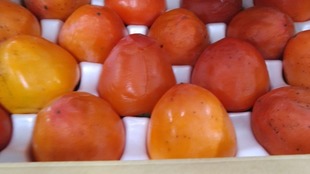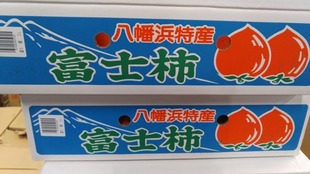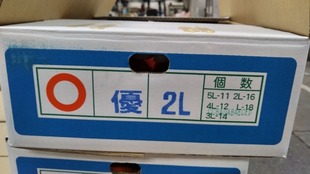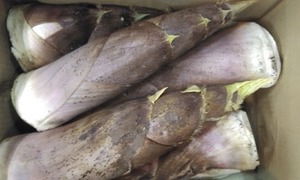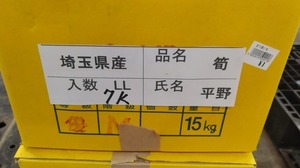【Product name】
Cauliflower
【Type】
Brassica oleracea var. botrytis
【Producing area】
Kasuya Town, Kasuya District, Fukuoka Prefecture (JA Kasuya, JA Zennoh Fukuren)
【Origin of name】
Dérivé de cauli fleuri, qui signifie chou fleur.
【Major features】
Momochihama store was broadcast live on TNC TV West Japan on December 11th at Mr. Shinsuke Hakoda’s farm in Kasuya Town, Kasuya District, which is under the jurisdiction of JA Kasuya, and promoted the appeal of seasonal cauliflower. Located in the section of village Okuma, Kasuya Town, ‘Nanomi no Sato’, which is popular with everyone, operates as a direct sales place for JA Kasuya district producers. In addition, it seems that they carefully select seasonal agricultural products from the Karatsu area of Saga Prefecture and sell them directly. In addition, it seems that they try to make sure that customers can enjoy seasonal items throughout the year. In the future, it seems that they will continue to create shops that are rooted in the region so that producers and consumers can be truly pleased. JA Kasuya has jurisdiction over Koga City, Shime Town, Kasuya County, Umi Town, Sue Town, Kasuya Town, Sasaguri Town, Hisayama Town, and Shingu Town. In formulating the 5th Koga City Basic Comprehensive Basic Concept, we have been working to improve the social structure of Japan due to changes in the demographic structure due to the rapid progress of declining birthrate, aging population and population decline, and increasing awareness of crisis management against various risks such as natural disasters. The economic situation has changed significantly. Under these circumstances, there is a need to make the most of the city’s strengths, regional characteristics, and useful resources cultivated by its predecessors, connect it to the future, and create a sustainable city that stably supplies necessary citizen services. Seems to be Based on a medium-to long-term perspective, we have formulated a basic concept as a guideline for sustainable urban development that indicates the future city image that the city should aim for and the basic policy to achieve it. As a plan for the conception period and promotion, the conception period is his 10 years from 2022 to 2031. Formulated an action plan showing specific measures and business operations to be implemented in order to realize the future city image positioned in the basic concept. In order to respond to changes in socio-economic conditions and to be effective, flexible, and responsive, the action plan will last four years and will be reviewed annually in a rolling manner. I will extract the rough form, but I would like to note the important items here. Policy 3-2 For the promotion of agriculture and forestry, aim (the image of the town that the policy is aiming for) to manage agriculture in a stable and sustainable manner, and create an excellent environment that maintains multifaceted functions such as agricultural production infrastructure, water resource cultivation, and disaster prevention. A town where farmland and forests are preserved is ideal. As measures and their direction, in order to conserve and effectively utilize farmland, improve agricultural productivity, and improve agriculture in the city, we will secure cohesive and excellent farmland through infrastructure development projects, Promote accumulation. In addition to being a place for agricultural production, it is also a place for the formation of rich rural landscapes, conservation of biodiversity, places for environmental education and learning, and water sources. In order to conserve farmland with multifaceted functions such as recharge, disaster prevention and mitigation, etc. as a valuable asset, support for activities to conserve farmland that is currently in use, promotion of farmland lending and borrowing for matching with appropriate farmers, cultivation. Elimination of abandoned farmland and systematic development and maintenance of agricultural facilities such as waterways and reservoirs are promoted. In addition, in order to promote sustainable farm management, new farmers, women farmers, community farming organizations, and other diverse actors to be motivated to engage in agriculture, we will provide support for training and establishment according to needs. At the same time, in order to enable sustainable agriculture in the future, we will produce rice, wheat, and other high-value-added horticultural crops, promote smart agriculture using robot technology and ICT, and prevent damage from harmful birds. Supporting efforts to stabilize agricultural management. In order to ensure that citizens and businesses can use local agricultural products as ingredients and ingredients with peace of mind, we are working to strengthen the functions of the cosmos museum and disseminate information on the appeal of agricultural products, promoting local production for local consumption. In addition, we support the expansion of sales channels in Japan and overseas by taking advantage of the proximity to large consumption areas and excellent transportation convenience. Together with producers, we will focus on the various functions and roles of agriculture, develop an interest in agriculture, food, the environment, etc., and make it possible for consumers to incorporate health promotion and environmentally friendly actions into their lives. Providing places and opportunities to experience farming. Promotion of forestry that protects forests, utilization of ICT based on the forest management system, efforts to clarify owners and boundaries, maintenance of healthy forests by clearing undergrowth and thinning, etc. Motivated and capable forestry managers In addition to promoting the consolidation of forestry operations in the forestry sector in the future, forests that are not suitable for forestry management will be diverted to forests that are closer to nature to maintain multifaceted functions. Agriculture in Kasuya Town is a suburban agriculture centered on paddy rice, and because it is adjacent to Fukuoka City, an ordinance-designated city, urbanization has progressed, and the farmer population seems to be decreasing year by year. The city has a long history of growing vegetables. In the old days, it was known as a production area of cabbage, but in recent years it seems to be famous as a production area of broccoli. In addition, Kayoicho Park (a symbol of the town, a sports and recreational space rich in nature where you can experience the workings of the four seasons. It seems that it is possible to use the field for light exercise such as walking and picnics while enjoying nature. From children to the elderly, it is used to improve health and refresh the mind according to the physical strength and age of each townspeople.) It seems that the roses that can be seen in the inner rose garden are also being cultivated. In addition, a large-scale commercial complex in Sakado Ward has a “Kasuya Agricultural Cooperative Specialty Corner” where vegetables harvested in the morning are exhibited. Hyakunin mound: Built near the entrance of 徳鳳山崇月院 Senzoji Temple. In 1732, the famine that swept across western Japan caused many victims in Sakado village, and it seems that 197 people lost their lives. It is said that this monument was erected seven years after the Kyoho famine, with the young people of the village playing a central role in collecting funds and praying for the well-being of the deceased. Eki Shrine: Located on the right side of Sannomiya Shrine worship hall. It is said that the shrine was built in hopes of warding off the epidemic that killed many people during the Kyoho era of the Edo period. The festival is held on May 8th every year, and until the end of the Meiji period, many people from other regions also attended the festival, and it seems that the food stalls were bustling with people. Since the number of epidemics has decreased, the role played by the plague shrine has become smaller, and festivals are no longer held. Fiscal 2022 Kasuya Town Paddy Agriculture Promotion Council Vision for Strengthening Paddy Profitability. It seems that the main type of agriculture is suburban agriculture. Apart from paddy rice, broccoli and other vegetables are the main crops. In recent years, the liberalization of imports of agricultural products, sluggish prices, and the expansion of the Fukuoka metropolitan area have led to demand for residential land, as well as land for commercial facilities and distribution facilities. It seems that both the number of farmers and the area of arable land under management are declining as a result of the expansion of demand for land, the conversion to residential land and commercial and industrial land is conspicuous. Along with this, there are concerns about a shortage of agricultural successors and an increase in dilapidated farmland. Policies and goals of efforts as a production area to strengthen profitability by introducing highly profitable crops and improving added value such as crop rotation. Planned production according to demand, barley and oatmeal. Relations with the Kasuya Agricultural Cooperative, etc., regarding the consolidation of farmland to farmers to improve the yield and quality of beans, the introduction of complexes and low-cost production technology, and the expansion of cropping of highly profitable horticultural items such as broccoli and soft vegetables. It seems that the agencies are working together and providing support. In addition, policy and goals as a production area for the effective use of paddy fields, including conversion to upland fields Production of upland crops only through on-site confirmation of fields based on the items described in the farm management plan submitted by the producer and the paddy field ledger. It seems that the state of paddy use will be inspected, such as whether there are any paddies that have not been planted for a long time as regulated paddies. Based on the results of the inspection, it seems that they will consider and promote the block rotation of paddy rice and vegetables, etc., and the conversion of paddy fields to upland fields where there is no prospect of paddy rice cultivation in the future. Regarding the policy for each crop, as for staple food rice, since the cultivation unit area of paddy rice is small and mainly farmers for self-consumption, Although it is difficult to make it a production area for use, it seems that they will continue to ask farmers for their cooperation in producing rice that meets demand. As for cultivation, we will thoroughly implement cultivation techniques such as the introduction of excellent varieties and appropriate fertilization management, and promote environment-friendly production such as soil preparation by applying organic matter. Currently, we are mainly planting varieties of ‘Yumetsukushi rice(Meshimaru Yume Tsukushi is a rice variety from Fukuoka, born from Koshihikari Park, which has a reputation for its deliciousness, from its father, and Kinuhikari rice, which is hardy and easy to grow, from its mother. The year of adoption was 1994, and the “dream” of Yume Tsukushi rice entrusts us with our dreams and hopes for the future. Seems to be included. Yume Tsukushi rice was born 20 years ago, and is the most popular rice produced in Fukuoka Prefecture, boasting the largest production volume in the prefecture, surpassing many others.)’, ‘Genki Tsukushi rice(An original variety from Fukuoka Prefecture, developed over 10 years to produce rice that grows well even in the high temperatures of summer. His mother is “Tsukushi Roman rice” and his father is “Wase Tsukushi Rice”. “Genki” means delicious rice that can withstand the heat and grows vigorously, giving energy to those who eat it.)’ and ‘Hinohikari rice(It was raised in 1989 at the Miyazaki Prefectural General Agricultural Experiment Station, and has “Koshihikari rice” as its father and “Koganebare rice” as its mother. Aiming for a delicious variety, we added two generations of selection to select strains that are as glossy as Koshihikari rice when cooked in a beaker. Yang represents western Japan and Kyushu, and it seems that the name comes from the fact that rice shines like the sun.)’. It seems that it promotes the cultivation of rice desired by consumers and actual users by guiding planting according to the use of the farmers. In addition, it seems that they are trying to improve the quality by thoroughly implementing countermeasures against high temperatures and switching to “Genki Tsukushi rice”, which is a breed grown in the prefecture. Although it is a highly profitable crop, it seems that vegetables and flowers for farmers’ markets are being planted in the conversion paddy fields. Currently, we are promoting the production and sales of a wide variety of crops, mainly through direct sales of agricultural products. Going forward, we will continue to promote the planting and sales of highly profitable vegetables and flowers by taking advantage of our location in the outskirts of the city. It seems that they will try to maintain and expand the area and expand their local production and consumption efforts. ‘Mugikurabe’, a cafe that offers breads made with Kyushu-grown barley and menus that use domestically-produced barley, such as barley drinks, is scheduled to open in Kasuya Town, Fukuoka Prefecture on February 1, 2023. It seems to be an antenna shop-like cafe aimed at expanding the use of domestic wheat. In addition, this facility is a type B facility that supports continuous employment, and I have heard that it is an “agriculture-welfare collaboration” type operated mainly by people with disabilities. “Agricultural welfare collaboration” is one of the initiatives that leads to the solution of problems in both the welfare field related to people with disabilities and the agricultural field, which is suffering from a shortage of successors. Business planning, etc., is carried out by Katabo Co., Ltd. under contract from the Japan Association for Improving Rice and Wheat, and zero medical Co., Ltd. (headquartered in Higashiyama, Meguro Ward, Tokyo) handles facility management, including the employment of staff for people with disabilities. The content is management consulting that promotes realization and CSV management, planning and operation of media using the Internet, and related production work, information provision services related to medical care, welfare, nursing care, etc. obtained through own media, sales support and sales promotion In addition to the production of websites for the purpose of, proposal, planning and development of various tools) seems to be done. Agriculture-welfare collaboration tends to be understood in the narrow sense of collaboration between agriculture and welfare (persons with disabilities). Diverse people with social difficulties, such as those with disabilities, the poor, and the legally handicapped, are included. In the vision for promoting agriculture-welfare collaboration, etc., announced in June 2019, “Agriculture-welfare collaboration is not limited to efforts to promote the active participation of persons with disabilities in the agricultural field, but as a universal initiative, it can be applied not only to agriculture but also to various industries. At the same time, it is also important to broaden and reconsider support for employment and social participation support for the elderly, the poor, and those in a state of social withdrawal, as well as recovery support for those who have committed crimes or delinquency.” Is specified. After that, in many situations, the expression “agriculture-welfare collaboration” changed to “agriculture-welfare collaboration, etc.” is the expectation for new value that will be created by expanding the meaning of agriculture and fortune. It seems empty. It should not be forgotten that people with disabilities may not be able to do all the work due to the characteristics of their disabilities. After ascertaining what can be done, it seems that sometimes it is necessary to separate the work and give guidance. In addition, it seems that it is difficult to acquire skills if employment is unstable. Depending on the weather, there are days when farm work can be done, and there are days when it cannot be done. If you can’t ask for work continuously, it seems that it may be difficult for people with disabilities to acquire skills. It also seems that special attention should be given to safety. Agriculture uses agricultural machines and tools. In order to work safely, it is necessary to explain how to use and operate the machine in a way that people with disabilities can understand. Excerpt from JA Kasuya. Cauliflower is said to grow at temperatures between 15 and 20 degrees Celsius, making it a heat-tolerant and cold-tolerant vegetable. Summer sowing and autumn / winter harvesting are the easiest times of the year to grow, and in warm regions, the sowing season is from mid-July to late August. As for cauliflower, flower bud formation depends on the size of the foliage and a certain amount of low temperature. Therefore, it is necessary to use different varieties in order to enjoy a long harvest. Wase varieties such as “Baroque” (Sakata seed), “Snow Crown” (Takii seedling), “Yukimatsuri” (Musashino Seedling), etc. Nakate variety “Teruzuki” (grass appearance, flower buds are pure white. Special quality) Mid-season species. December to February in general flat and warm areas. Outer leaves are dark green and grow vigorously. The grass is upright, and the core leaves wrap the flower buds well to prevent discoloration due to sunburn. The flower buds are pure white and swell. Good firmness, firmness and slow loosening. It is sown in August in generally mild areas and harvested from December to late February.)” (Nozaki Seed), “Snow Dress” (Takii seed) Misei® (cultivar for dense planting with very compact stems, leaves and flower buds). Wase cultivar with excellent heat resistance that can be harvested around 70 days after planting. It has a weighty feel, is juicy and delicious, and is suitable for eating raw. It exhibits its characteristics best when harvested with flower buds with a diameter of about 10 cm (350 g)” (Sakata Seed), “Cauliflore” with stick-shaped flower stalks (Tokita) It seems that there are also unique varieties such as seedlings).

Cauliflower is thought to have its roots in wild kale, and is said to have branched off from its ancestors in the cruciferous family, which is the same as Chinese cabbage and cabbage. Cauliflower is thought to be a mutated form of broccoli, which eats flower buds and is related to broccoli. Originally from the Mediterranean coast, it was introduced to Japan in the Meiji era, but it seems that it did not become very popular at the time. Demand increased with the westernization of food after World War II. Kayocho (Originally a gayo for a noble person to ride, it refers to a person who carries Horen or a palanquin. The person who carries Horen or Mikoshi is a lower-ranking official who belongs to the Japanese Imperial Court. Nowadays, Kakoshicho means a portable shrine. Kayocho Pond that spreads throughout the ward (It is written in an ancient document that it was built by Shigeemon Kawamura, who was a county shogunate administrator, in 1697 during the Edo period and became the current shape.) It used to be one of the three major ponds in Chikuzen.However, various relics such as stone tools from the Paleolithic and Jomon periods can be collected from the bottom of the pond. It seems that traces of people’s habitation can be confirmed here.) It is counted as one of the three major ponds in Chikuzen. It seems that it was sung as “Kayocho of Kasuya”. In addition, it is said that this pond, which has a circumference of about 4 kilometers, is divided into eight entrances and exits, and that “Orochi” lives in it, with one head sticking out of each cove. Few people swim there, and when there were occasional drownings, it was feared that it was the work of the Orochi. There is also a legend that a copper hanging bell is sunk in the pond in front of Kakoshi Hachiman as an amulet. Now it is maintained as a park, and the old legend has faded.

This excellent agricultural product has recently been attracting attention as a diet food and as a measure against diabetes. A large amount of dietary fiber is good food for good bacteria in the intestines, increases the bulk of stools, and maintains an appropriate amount of water to prevent and improve constipation and improve the intestinal environment. It is said that regulating the intestinal environment is important for making a body that is easy to lose weight. In addition, prevention and improvement of constipation seems to lead to control of cholesterol. It also has the potential to prevent rapid spikes in blood sugar levels.

For ATP-inhibited nucleases from cauliflower inflorescence meristems: A general term for nucleases that hydrolyze the phosphodiester bond between the sugar and phosphate of deoxyribonucleic acid or ribonucleic acid to nucleotides. A thermostable Cas9 nuclease. The present invention appears to be related to the field of genetic engineering, and more particularly to nucleic acid editing and genome modification. An isolated Cas protein or polypeptide fragment thereof having the amino acid sequence of SEQ ID NO: 1 or a sequence at least 77% identical thereto, which is capable of cleaving DNA at temperatures ranging from 50°C to 100°C. provides a Cas protein or polypeptide capable of Further provided are isolated nucleic acid molecules, expression vectors and host cells encoding said Cas9 nuclease. The Cas9 nuclease disclosed herein is a novel tool for genetic engineering at high temperatures and appears to be of particular value in the genetic engineering of thermophilic organisms, especially microorganisms (JP2018522544A, Japan: Professor Seisuke Kimura, affiliation : Department of Industrial Life Science, Faculty of Life Science, Kyoto Sangyo University. Date of presentation, 1998/12/16.)





